| Okay, you've read enough for now. It's time to get some hands-on experience. Go ahead and launch LabVIEW. You'll step through the creation of a simple LabVIEW VI that generates a random number and plots its value on a waveform chart. You'll learn more in the next chapter about the steps you'll be taking; for now, just get a feel for the environment. If you're using the full version of LabVIEW, just launch it and you'll be ready to start building your first VI. If you're using the evaluation version of LabVIEW, you can still do these activities, because the evaluation version of LabVIEW has no restrictions on creating and editing VIs. Just be aware that the evaluation version of LabVIEW stops working after 30 days. After that point, you'll need to buy a license key to activate your LabVIEW software. 
If you're not comfortable working through the activities in this chapter without more background information or have trouble getting them to work, read Chapter 4, "LabVIEW Foundations," and then come back and try again.
1. | Launch LabVIEW (if it's been open, you can quit it first).
| | | 2. | At the LabVIEW Getting Started dialog, click Blank VI to create a new blank VI (the Blank VI option is found under the New heading, and you have to click on the "Blank VI" text, not the icon). An "Untitled 1" VI front panel will appear on your screen.
Go to the floating Controls palette and navigate (by clicking) to the Modern>>Graph subpalette, shown in Figure 3.17. If the Controls palette isn't visible, select View>>Controls Palette from the menu to make it visible. Also, make sure the front panel window is active, or you will see the Functions palette instead of the Controls palette.
Figure 3.17. Modern>>Graph palette showing the Waveform Chart and various other charts and graphs 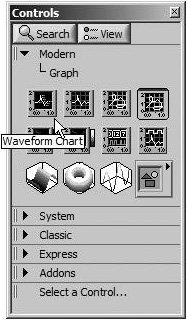
On the Graph subpalette, select Waveform Chart by clicking it with the mouse button. You will notice that, as you run the cursor over the icons in the Controls palette and subpalettes, the selected button or icon's name appears in a tip strip, as shown in Figure 3.17.

Positioning Tool
You will see the outline of a chart with the cursor "holding" it, as shown in Figure 3.18. Position the cursor in a desirable spot on your front panel and click. The chart magically appears exactly where you placed it, as shown in Figure 3.19. If you want to move it, select the Positioning tool from the Tools palette, and then drag the chart to its new home. If the Tools palette isn't visible, select View>>Tools Palette from the menu.
Figure 3.18. Waveform Chart after it has been dragged onto the front panel (and before it has been dropped) 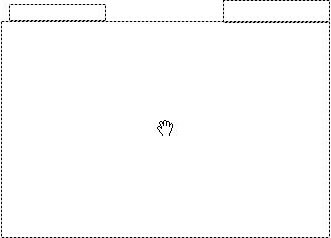
Figure 3.19. Waveform Chart after it has been dropped onto the front panel 
| | | 3. | Go back to the Modern subpalette; then navigate into Boolean subpalette, and choose Stop Button (see Figure 3.20).
Figure 3.20. Modern>>Boolean palette showing the Stop Button and other Boolean controls and indicators 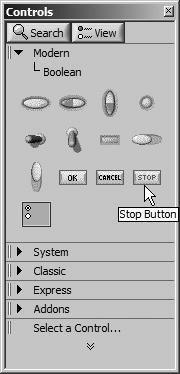
Place it next to the chart, as shown in Figure 3.21.
Figure 3.21. Your VI front panel, after adding a Waveform Chart and Stop Button 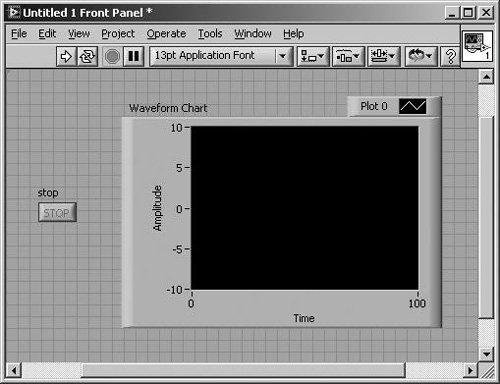
| | | 4. | Now change the chart's Y-axis scale range from -10 thru +10 to 0 thru 1. Highlight the number "10" (Y-axis range max) by click-dragging or by double-clicking on it with the Text Edit tool. Now type in 1.0 and click on the enter button that appears in the Toolbar at the top of the window. Change -10 (Y-axis range min) to 0 in a similar manner.

Enter Button
| | | 5. | Switch to the block diagram by selecting Show Block Diagram from the Window menu. You should see two terminals already there, as shown in Figure 3.22.
Figure 3.22. Your VI block diagram, showing the Stop Button and Waveform Chart terminals 
| | | 6. | Now you will put the terminals inside a While Loop to repeat execution of a segment of your program. Go to the Programming>>Structures subpalette of the floating Functions palette and select the While Loop (see Figure 3.23). Make sure the block diagram window is active, or you will see the Controls palette instead of the Functions palette.
Figure 3.23. Programming>>Structures palette showing a While Loop and other LabVIEW structures 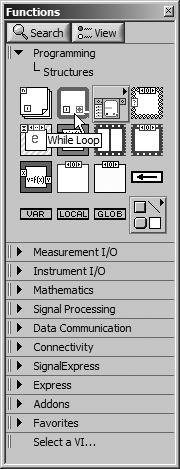
Your cursor will change to a little loop icon. Now enclose the DBL and TF terminals: Click and hold down the mouse button while you drag the cursor from the upper-left to the lower-right corners of the objects you wish to enclose (see Figure 3.24).
Figure 3.24. Dragging the mouse cursor to place a While Loop on the block diagram around a region of code 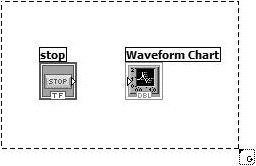
When you release the mouse button, the dashed line that is drawn as you drag will change into the While Loop border (see Figure 3.25). Make sure to leave some extra room inside the loop.
Figure 3.25. A While Loop containing the code that was enclosed by the dragged region 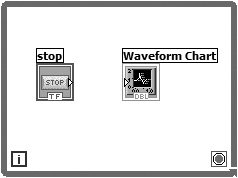
| | | 7. | Go to the Functions palette and select Random Number (0-1) from the Programming>>Numeric subpalette. Place it inside the While Loop.
The While Loop is a special LabVIEW structure that repeats the code inside its borders until the conditional terminal reads a TRUE value (when configured to Stop if True, appearing as a small red stop sign  ). It is the equivalent of a Do-While Loop in a more conventional language. ). It is the equivalent of a Do-While Loop in a more conventional language.

You can configure the conditional terminal of the While Loop to Continue if True (appearing as a small green loop  ), from its pop-up menu or by clicking on it with the Operating tool. You'll learn more about While Loops in Chapter 6, "Controlling Program Execution with Structures." ), from its pop-up menu or by clicking on it with the Operating tool. You'll learn more about While Loops in Chapter 6, "Controlling Program Execution with Structures."
| 8. | With the Positioning tool active, arrange your diagram objects so that they look like the block diagram in Figure 3.26.

Positioning Tool
Figure 3.26. Your block diagram after placing the Random Number (0-1) function 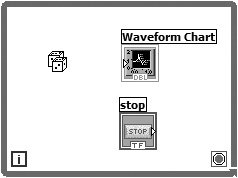
| | | 9. | With the Wiring tool active, click once on the Random Number (0-1) icon, drag the mouse over to the Waveform Chart's terminal, and click again (see Figure 3.27).

Wiring Tool
Figure 3.27. Your block diagram, as you drag a wire from the Random Number (0-1) function to the Waveform Chart terminal 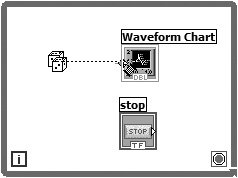
You should now have a solid orange wire connecting the two icons, as shown in Figure 3.28. If you mess up, you can select the wire or wire fragment with the Positioning tool and then hit the <delete> key to get rid of it. Now wire the Boolean TF terminal to the conditional terminal of the While Loop. The loop will execute while the switch on the front panel is FALSE (not pressed down) and stop when the switch becomes TRUE (pressed down).
Figure 3.28. Your block diagram after completing the wiring tasks 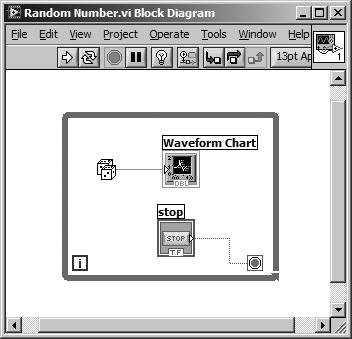
| | | 10. | You should be about ready to run your VI. First, switch back to the front panel by selecting Show Front Panel from the Window menu. Now click on the run button to run your VI. You will see a series of random numbers plotted continuously across the chart. When you want to stop, click on the stop Boolean button using the Operating tool (see Figure 3.29).

Run Button

Operating Tool
Figure 3.29. Your VI front panel after pressing the Run button 
| | | 11. | Create a directory or folder called MYWORK in a convenient location (such as your home or documents directory). Save your VI in your MYWORK directory or folder by selecting Save from the File menu and pointing out the proper location to save to. Name it Random Number.vi.

Save all of your subsequent activities in MYWORK so you can find them easily! 
Remember if you get stuck or just want to compare your work, the solutions to every activity in this book can be found in the EVERYONE directory or folder on the accompanying CD. You can view them in the sample version or the full version of LabVIEW. Congratulate yourselfyou've just written your first LabVIEW program! Don't worry that it doesn't actually DO much; your programs will be more powerful and have more of a purpose soon enough!
|
|














